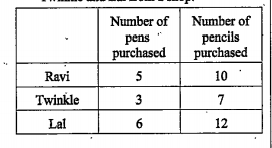Find the unit vector along →a−→b where →a=i+3j−k and →b=3i+2j+k.Solution in Malayalam
Step by step video & image solution for Find the unit vector along veca-vecb where veca=i+3j-k and vecb=3i+2j+k. by Maths experts to help you in doubts & scoring excellent marks in Class 12 exams.
Updated on:21/07/2023Topper's Solved these Questions
Similar Questions
Consider the following information regarding the purchase of pens and penciles by the three students Ravi, Twinkle and Lal from a shop.
 Represent the above data in the form of a 3×2 matrix. What does the entry in the 2nd row and in the first column represent?
Represent the above data in the form of a 3×2 matrix. What does the entry in the 2nd row and in the first column represent?
View SolutionLet A be the set of all 50 students of class X in a school. Let f:A→N
be function defined by f(x) = roll numbers of the student x. Show that
f is one-one but not onto
View SolutionIf vectors vecA and vecB are 3i -4j + 5k and 2i + 3j - 4k respectively then find the unit vector parallel to vecA + vecB
View SolutionFind a unit vector perpendicular to each of the vectors (→a+→b)and (→a−→b), where →a=ˆi+ˆj+ˆk,→b=ˆi+2ˆj+3ˆk.
View SolutionIf →a and →b are two unit vectors such that →a+→b is also a unit vector, then find the angle between vectors →a and →b.
View SolutionFind →a+→b,→a−→b and →b+→c using the vectors.
→a=3i+4j+k,→b=2i−7j−3k and →c=2i+3j−9k.
View SolutionIf →a=3i+j+2k,
If the projection of →a on another vector →b is √14, which among the following could be →b ?
i+j+k
6i+2j+4k
3i-j+2k
2i+3j+k
View SolutionLet →a=2i+4j−5k, →b=i+2j+3k. Then find a unit vector perpendicular to both →a and →b .
View SolutionConsider →a=i+2j−3k,→b=3i−j+2k,→c=11i+2j. Find →a+→b and →a⋅→b.
View SolutionConsider →a=i+2j−3k,→b=3i−j+2k,→c=11i+2j. Show that →a+→b and →a−→b are orthogonal.
View SolutionIf →a=i−j+k and →b=2i−2j−k. What is the projection of →a on →b?
View SolutionFind the unit vector along →a−→b where →a=i+3j−k and →b=3i+2j+k.
View SolutionFind the angle between the vectors →a=3i+4j+k and →b=2i+3j−k.
View SolutionConsider the vectors →a=i−7j+7k,→b=3i−2j+2k.Find the angle between →a and →b.
View SolutionConsider the vectors
→a=i−7j+7k,→b=3i−2j+2k.
Find the area of parallelogram with adjacent sides →a and →b.
View SolutionFind a unit vector perpendicular to →a+→b and →a−→b, where →a=i−3j+3k and →b=3i−3j+2k.
View Solution
